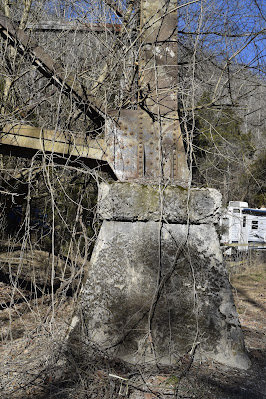Back in January we visited the Nemo area in Morgan County where we rekindled our interest in bridges and tunnels. We perfectly timed our visit to the abandoned Nemo Tunnel #24 just when a train roared out of the active tunnel parallel to it. That experience whetted our interest in railroad tunnels, trestles and bridges. A little research online led us to some amazing trestles in East Tennessee. A sunny spring-like day in February provided the perfect opportunity to explore and trestle trek.
In a remote corner of Claiborne County we located the Lonesome Valley Bridge, a towering structure aptly named because it spans a deep valley at Daniels Gap.
The current metal structure replaced a timber trestle built in 1888-1889 but which tragically collapsed under the weight of a freight train June 14, 1892. The train plunged into the narrow valley killing the engineer, fireman and conductor. Two brakemen survived but suffered serious injuries.
Friday, February 26, 2021
Trains, Trestles and Tunnels Part 1
According to various reports, the train consisted of 2 or 3 engines and 14-17 cars, mostly coal cars, bound for Knoxville, TN from Middlesboro, KY. Train personnel had expressed misgivings about the structural integrity of the timber trestle and carefully approached the bridge at a reduced speed of about 20 miles per hour. However, the wooden bridge structure was not secure enough to bear the weight of the train. Upon reaching the edge of the trestle, the first engine hit the weakened segment, plunged downward pulling the other cars behind into the ravine.
Spanning 300 yards and reaching 140 feet from the valley floor, the "new" trestle bridge inspires awe. Imagine the view a train engineer would enjoy passing over this deep valley!
Imagine the faith it takes to cross this trestle!
Several times a week the Norfolk Southern Railway trains pass over this incredibly fragile-looking structure.
The footings show some erosion but remain secure.
A closer inspection shows the riveting.
Lonesome Valley Road, a gravel road in this area, passes beneath the giant trestle. Hidden in the vines beside the current footers are the old footers from the 1889 timber trestle.
It is difficult to capture the enormity of the structure.
I marvel at the ingenuity God has given man has to build such engineering feats.
Anchored on the north end, a section appears more recently painted.
Some of the locals have stories of their grandparents crossing the trestle as kids.
Standing farther back from the trestle, I still could not capture the entire structure in a photograph.
Because we got started after lunch, we knew that we would have to hustle to find our next destination, the Norfolk Southern bridge over the Powell River. Our trek would take us to Harrogate near Cumberland Gap where we would follow Gap Creek along a gravel road to the railroad bridge spanning the Powell River.
We came upon a section of the railroad spanning a small creek (Yellow Creek) and a gravel road (Marsee Spring Road). Even this trestle impressed us!
Directly across from the railroad trestle Gap Creek flowed under a rickety wooden bridge accessing a barn and field. Notice the road work where the shoulders and creek bank have been shored up and re-enforced. I imagine flooding is a frequent problem in some low-lying areas along the stream.
Upon closer inspection of the bridge, I'm not sure that I would have trusted it with any weight!
The gravel road leading away under the trestle invited us to explore another day.
I need to research the Gap Creek area. I have several questions. Is this Gap Creek the same creek which flows out of Gap Cave in Cumberland Gap? Does it travel underground for a portion of its trek? Was there once a mill situated at this small dam?
The picture below tells a story. Where the railroad lies well above the stream, the gravel road travels close to the stream and even partially fords the stream to allow vehicles to cross. Fortunately for us, we didn't have to cross the stream because a fork to the right allowed us to continue on downstream. Recent rains and snow melt caused washouts and erosion. The county workers were busy installing a culvert bridge to by-pass the stream ford.
We reached our destination! Except for two women enjoying a warm day with the temperatures near 70 degrees, Chris and I were the only people at the site. A local story is told of how children would walk across the bridge to go to school. One day a little girl followed by some neighbors crossed the trestle only to discover that a train was coming. Without enough time to outrun the train, the little girl dropped down as did the other children and held on as the train passed. All survived! I wonder if they told the story that day or waited until they were adults to relate the incident?
The design is a Warren deck truss bridge. Simply stated, a Warren Truss uses equilateral triangles to spread out the loads on the bridge.
Look closely to the left to see where Gap Creek empties into the Powell River.
This shot looks upstream a few yards from the stream's confluence with the Powell River.
On our return out of the valley, we had to wait while the construction guys secured their acetylene tank.
I am now hooked on researching and locating unique train trestles and metal bridges...and maybe a few abandoned tunnels. East Tennessee is rich in scenic beauty, unique structures and resourceful people.
Subscribe to:
Post Comments (Atom)



























No comments:
Post a Comment